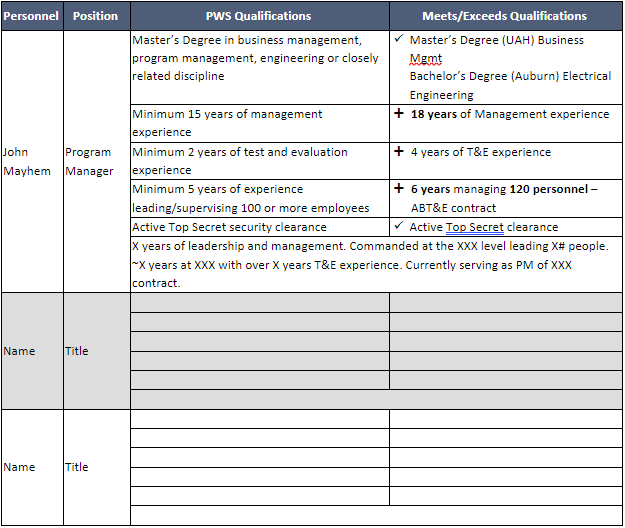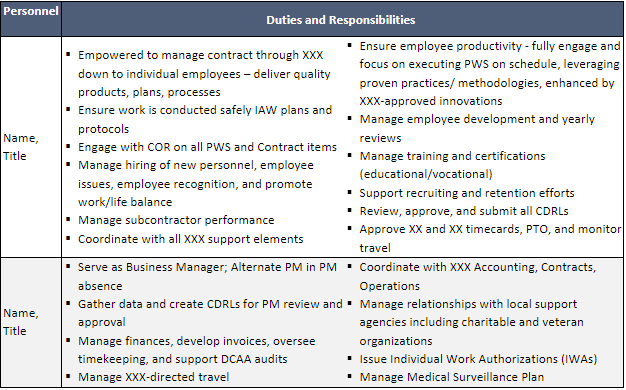2 min read
New OneTeam Features - February 2024
OneTeam users will notice a few new changes beginning February 2024. We released updates and new features to give our...
By: Donna T. Hamby, CP.APMP on May 4, 2023 8:24:00 AM

When bidding federal government contracts, it is not simply enough to submit the ‘best’ proposal, have the lowest price, or have a well-liked Program Manager. It is a combination of all these things and much more that helps your company win a contract. A winning contractor must satisfy all the criteria as detailed in the RFP and be viewed as the low-risk choice.
The Management Plan should emphasize the contract management team as a strength and an asset to the government customer. One of the best ways to present the contract management team is to use a multi-layered approach. It has been popular in the past to use complex tables or charts that display a lot of information in one graphic. But for conveying this critical information to the evaluation team, it might be better to break the information down into more manageable sections.
Here is an overview of how to present the Contract Management Team as an asset to the customer. Start with an overall big picture approach and then move to more detailed information, as shown below.
The Big Picture – Show the proposed Team using an Org Chart detailing the customer, contractor, and contract management team.
RFP Qualifications – Align your management team to the RFP qualifications and requirements for key or critical personnel.
Authority and Responsibility – Demonstrate the lines of authority and responsibilities of the contract management team, corporate support, and their relationship to the customer.
Detailed Duties and Responsibilities – Summarize the duties and responsibilities of key and critical personnel use positive action verbs that resonate with the customer.
Start with an Organizational Chart, which is a clear and easy-to-read chart showing:
An example organizational chart is shown below. If your contract includes a Program Management Office (PMO) or a business office with program control, business manager, HR, etc, show it the org chart also. The example also shows there are three positions/people who make up a Project Management Office.

Next, move beyond the names and titles, with a Key Personnel Table that lists each person, their position, and qualification details. Some RFPs do not stipulate key personnel, or the ones they do require do not provide the bidder with the best way to present their proposed team.
If the proposed personnel are a strength for the team, find a way to include them in the charts. An example would be a Lab Lead who is a recognized expert in their field and has run the lab for 20 years. Call this a critical position and put it on the chart. Qualifications should include:
Listing the personnel names down the left side makes the data easy to read and understand. Most people scan data the first time, and sometimes go back and read again to gather more detail.

As part of the management plan, include an authority and responsibility chart. Customers are often concerned with how easily they can communicate with the PM and how much authority the PM has to make decisions. Customers also appreciate having an executive level manager that is genuinely motivated to ensure contract success and provide performance-based metrics.
This type of delegation of authority for the PM to make things right for the customer is especially critical for quick-turn actions, or if the corporate manager is time zones away and approval has not been timely with current or previous contractors.
The next level is to provide bullet points of the duties and responsibilities of the key personnel. This shows that your team has a deep understanding of the customer and the work to be performed. Be sure to gather data during the capture process so you know what the key duties and responsibilities are for each position.

Some proposal managers choose to combine the information from the duties and responsibilities information with the RFP qualifications table, shown previously. This technique can work, but it is a lot of data to present and expect evaluators to digest in one reading.
Your proposal outline, which is based on the RFP Section L requirements, will drive how this information is best presented. Always, always follow Section L requirements and make the volume as easy as possible to read, scan, digest, recall, and evaluate.
This is the 1st blog post in the 11-part series, "Playing to Win: Strategies to Scoring Higher and Winning Federal Government Contracts". There is a companion download, which includes editable customizable PowerPoint and Word graphics such as a capability matrix, strengths charts, recruiting and retention graphic, quality management graphics, technical approach graphic ideas, and much more.
OneTeam is a complete, secure, cloud-native collaboration platform for GovCons to track, qualify, capture, propose and win more contracts with fewer resources by streamlining and automating processes. Our experienced team writes extensively about business development topics and best practices.
Feb 23, 2024 by OneTeam
OneTeam users will notice a few new changes beginning February 2024. We released updates and new features to give our...
Nov 20, 2023 by Donna T. Hamby, CP.APMP
As November approaches each year, our thoughts turn to Thanksgiving with the celebrations of food, family, and...
Aug 23, 2023 by OneTeam
OneTeam users will notice a few new changes beginning August 18, 2023. We released updates and new features to give...